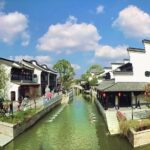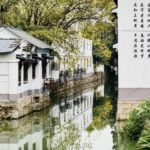The northwest end of Shantang Street leads to Tiger Hill, and the southeast end is at Changmen. The street runs parallel to Shantang River. Ancient bridges span the river. On both sides of the flagstone street are old houses with white walls and black tiles and numerous shops. At night, the lit red lanterns are reflected in the river, which is suitable for taking photos. You can also take a cruise or find a teahouse to drink tea and listen to Pingtan. Shantang Street runs from southeast to northwest, with a total length of about seven li. Hence, it is called ‘Seven Li Shantang’. Shantang Street has a history of thousands of years. It was constructed under the supervision of Bai Juyi, a poet of the Tang Dynasty, when he was an official in Suzhou. Now, at the southern end of the street, you can see Bai Gong Temple built by the people to commemorate Bai Juyi. Emperor Qianlong of the Qing Dynasty had a special preference for Seven Li Shantang. The imperial stele pavilion with the words ‘Seeking Beauty in Shantang’ written by his imperial brush is still well preserved. Here are also historic sites such as memorial arches, ancestral temples, and guild halls. There are more than a dozen guild halls alone. They were once the Suzhou offices of out-of-town chambers of commerce and were mostly built in the middle of the Qing Dynasty. The southeast part of Shantang Street, that is, a small section near Changmen, is called ‘Shantang Old Street’, which is about 360 meters long. This section has a relatively dense concentration of shops, gathering various handicraft stores and snack bars. There are also major scenic spots such as Yuhan Hall, Antai Fire Brigade, Tonggui Bridge, Suzhou Chamber of Commerce Museum, and ancient stage. It is the place with the strongest commercial atmosphere and the largest number of tourists on the entire street. Yuhan Hall is the former residence of Wu Yipeng, the minister of personnel in the Ming Dynasty. It is an ancient architectural complex outside Suzhou city. This building gathers various forms of Chinese rooms such as halls, chambers, towers, pavilions, and study rooms. Through the carved beams and painted pillars here, you can feel the strong cultural and artistic characteristics of the Ming Dynasty. Tonggui Bridge is an arched stone bridge spanning Shantang River. It is a good place to appreciate the water town scenery of Suzhou and is also a classic location for oil paintings and watercolor paintings. People who are carefully painting can often be seen on the bridge. Moreover, award-winning films such as ‘Plum Blossom Scarf’ and ‘Blush’ were also filmed here in the early years. There are many traditional old food stores on Shantang Street, including large restaurants like Songhelou, as well as snack bars with good quality and low prices like Rongyanglou and New Year Snack Shop. There are also dim sum stores like Huangtianyuan Cake Store and Caizhizhai Candy Store. You can taste traditional snacks such as plum blossom cake, begonia cake, and red bean paste porridge. And folk craft stores selling antiques, calligraphy and paintings, carvings, paper-cuttings, etc. are everywhere.
Opening hours: Open all day all year round.
Service facilities: Parking lot: [Xinmin Bridge Parking Lot]. Reference price: ¥6/hour. Address: Xinmin Bridge. Number of parking spaces: 60.
Shantang Street
The northwest end of Shantang Street leads to Tiger Hill, and the southeast end is at Changmen. The [...]









